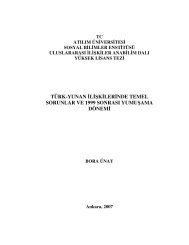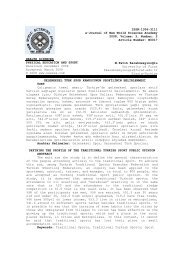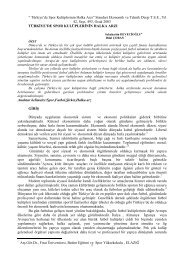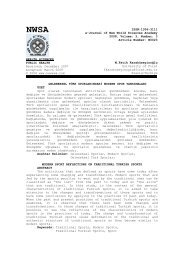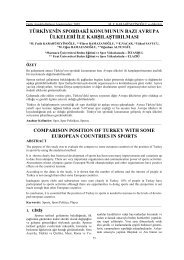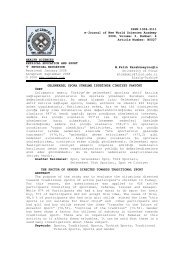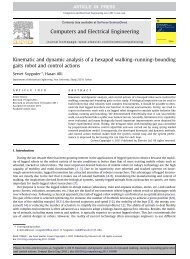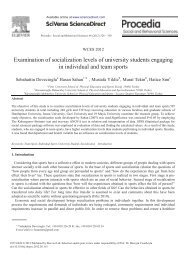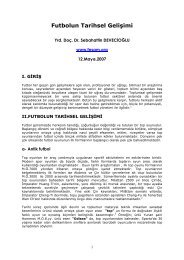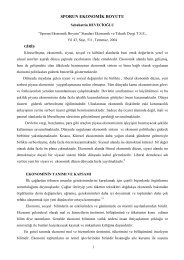Investigation on machinability of nodular cast iron by WEDM ...
Investigation on machinability of nodular cast iron by WEDM ...
Investigation on machinability of nodular cast iron by WEDM ...
Create successful ePaper yourself
Turn your PDF publications into a flip-book with our unique Google optimized e-Paper software.
3. ULUSLARARASI İLERİ TEKNOLOJİLER SEMPOZYUMU, 18-20 AĞUSTOS 2003, ANKARA<br />
<str<strong>on</strong>g>Investigati<strong>on</strong></str<strong>on</strong>g> <strong>on</strong> <strong>machinability</strong> <strong>of</strong> <strong>nodular</strong> <strong>cast</strong> ir<strong>on</strong> <strong>by</strong> <strong>WEDM</strong><br />
a Niyazi ÖZDEMİR, b Cebeli ÖZEK, a Nuri ORHAN<br />
nozdemir@firat.edu.tr, cozek@firat.edu.tr, norhan@firat.edu.tr<br />
a Department <strong>of</strong> Metal, Faculty <strong>of</strong> Technical Educati<strong>on</strong>, University <strong>of</strong> Fırat,<br />
23190, Elazığ, Turkey<br />
b Department <strong>of</strong> Machine, Faculty <strong>of</strong> Technical Educati<strong>on</strong>, University <strong>of</strong> Fırat,<br />
23190, Elazığ, Turkey<br />
Abstract<br />
Wire electric discharge machining (<strong>WEDM</strong>) is suitable especially for the<br />
materials, which can not be machining with c<strong>on</strong>venti<strong>on</strong>al machining methods. In this<br />
study, the <strong>machinability</strong> <strong>of</strong> standard GGG40 <strong>nodular</strong> <strong>cast</strong> ir<strong>on</strong> <strong>by</strong> <strong>WEDM</strong> using<br />
different parameters (machining voltage, current, wire speed and pulse durati<strong>on</strong>) was<br />
investigated. From the results, the increase in surface roughness and cutting rate<br />
clearly follows the trend indicated with increasing discharge energy as a result <strong>of</strong><br />
increase <strong>of</strong> current and pulse -<strong>on</strong> time, because the increased discharge energy will<br />
produce larger and deeper discharge craters. Three z<strong>on</strong>es were identified in rough<br />
regimes <strong>of</strong> machining for all samples: decarburised layer, heat affected layer and<br />
bulk metal. High machining efficiency can be obtained when selected the proper<br />
electrical parameters, but, whether high energy or the low energy is used, a coarse<br />
surface is always obtained.<br />
Keywords: Wire electric discharge machining (<strong>WEDM</strong>), <strong>nodular</strong> <strong>cast</strong> ir<strong>on</strong><br />
1.Introducti<strong>on</strong><br />
Nodular <strong>cast</strong> ir<strong>on</strong> is becoming popular for many engineering applicati<strong>on</strong>s <strong>on</strong><br />
account <strong>of</strong> their potantiel advantages (i.e. having high strength and toughness, good<br />
fatigue and wear resistance). Due to the metallurgical nature <strong>of</strong> these materials, the<br />
machining <strong>of</strong> these materials with the c<strong>on</strong>venti<strong>on</strong>al machining techniques such as<br />
milling and turning are problematic and difficult [1,2]. Wire electric discharge<br />
machining (<strong>WEDM</strong>) is suitable especially for the materials which can not be<br />
machining with c<strong>on</strong>venti<strong>on</strong>al machining methods[3]. <strong>WEDM</strong> is an electrothermal<br />
process where the material removal mechanism is achieved <strong>by</strong> electrical discharges<br />
occurring between an anode (usually the tool electrode) and a cathode (the worcpiece)<br />
submerged in a fluid dielectric. These electrical discharges melt and vaporize minute<br />
amounts <strong>of</strong> the work material, which are then ejected and flushed away <strong>by</strong> the<br />
dielectric[4,5]. Applicati<strong>on</strong> <strong>of</strong> electrical pulse creates an intense electrical field at the<br />
point where surface irregularities provide the narrowest gap between the workpiece<br />
and electrode and results in the formati<strong>on</strong> <strong>of</strong> high-c<strong>on</strong>ductivity bridge in the medium<br />
across the gap[6]. The increase <strong>of</strong> the voltage or decrease <strong>of</strong> the gap between the<br />
1
3 RD INTERNATIONAL ADVANCED TECHNOLOGIES SYMPOSIUM, AUGUST 18-20, 2003, ANKARA<br />
workpiece and the electrode results in vaporizati<strong>on</strong> and i<strong>on</strong>izati<strong>on</strong> <strong>of</strong> dielectric in the<br />
high-c<strong>on</strong>ductivity bridge and forms a spark channel between the two surfaces[7,8].<br />
The structural changes <strong>of</strong> electro-discharge machined surfaces and the<br />
influences <strong>of</strong> machining input parameters <strong>on</strong> the performance <strong>of</strong> <strong>WEDM</strong> have been<br />
widely reported in the literature, for tool steels. But the influences <strong>of</strong> electrical<br />
parameters <strong>on</strong> the surface microstructure <strong>of</strong> machined workpiece in the <strong>WEDM</strong><br />
process have not been studied for <strong>cast</strong> ir<strong>on</strong>s. The main aim <strong>of</strong> this research was to<br />
investigate effect <strong>of</strong> machining input parameters (machining voltage, current and wire<br />
speed) <strong>on</strong> the surface roughness and surface microstructure <strong>of</strong> <strong>nodular</strong> <strong>cast</strong> ir<strong>on</strong> <strong>by</strong><br />
<strong>WEDM</strong>.<br />
2.Materials and experimental procedures<br />
In this experiment, standard GGG40 <strong>nodular</strong> <strong>cast</strong> ir<strong>on</strong> was used as the<br />
machining workpiece. Chemical compositi<strong>on</strong> and physical properties <strong>of</strong> <strong>nodular</strong> <strong>cast</strong><br />
ir<strong>on</strong> are given Table 1 and 2 respectively. The samples were machined <strong>on</strong> a A300<br />
Fine Sodick Mark XI EDM electro discharge machine with isopulse generator and<br />
pure water was used as the dielectric liquid. In all the experiments, dielectric flow<br />
pressure <strong>of</strong> 1 bar, tensi<strong>on</strong> <strong>of</strong> the wire <strong>of</strong> 1133 g, diameter <strong>of</strong> the brass wire <strong>of</strong> 0,25 mm<br />
are kept as c<strong>on</strong>stant. Nine <strong>of</strong> the tests were performed using a range <strong>of</strong> <strong>WEDM</strong><br />
c<strong>on</strong>diti<strong>on</strong>s shown Table 3. After machining, the following experimental techniques<br />
were used to evaluate the surface microstructure and surface roughness <strong>of</strong> machined<br />
workpieces. For the surface roughness measurements <strong>of</strong> the machined workpieces, a<br />
portable device called “Mitutoyo Surftest 211” was used. Microstructural changes <strong>of</strong><br />
samples after the each machined process were observed <strong>by</strong> optical microscopy. The<br />
perpendicular surfaces to the machined surfaces <strong>of</strong> the specimens were polished with<br />
200-1200 mesh emery paper and cleaned in an acet<strong>on</strong>e bath and etched with 2 % nital<br />
after polishing 3 µm diam<strong>on</strong>d paste.<br />
Figure 1. Schematic diagram <strong>of</strong> the cutting process and examinati<strong>on</strong> surfaces.<br />
2
3. ULUSLARARASI İLERİ TEKNOLOJİLER SEMPOZYUMU, 18-20 AĞUSTOS 2003, ANKARA<br />
Table 1. Chemical compositi<strong>on</strong> <strong>of</strong> the test material<br />
Alloy<br />
Element<br />
C Si S P Mn Ni Cu Sn Mg Cr Ti Mo<br />
Wt %<br />
3,588 1,918 0,006 0,014 0,261 0,507 0,271 0,094 0,054 0,642 0,007 0,613<br />
Experimental<br />
series no<br />
Table 2. Physical properties <strong>of</strong> the test material<br />
Tensile strength (N/mm 2 ) 420<br />
El<strong>on</strong>gati<strong>on</strong> (%) 26<br />
Modulus <strong>of</strong> elasticity (N/mm 2 ) 175<br />
Hardness (BHN) 215<br />
Density (g/cm 3 ) 7,2<br />
Thermal c<strong>on</strong>ductivity (W/m.°K) 35<br />
Electric resistivity (µ.Ω.m) 0,35<br />
Circuit<br />
voltage<br />
(V)<br />
Table 3. Experimental c<strong>on</strong>diti<strong>on</strong>s.<br />
Current<br />
(A)<br />
Wire<br />
speed<br />
(m/min)<br />
3<br />
Factors<br />
Machining<br />
time (min)<br />
Surface<br />
roughness<br />
Ra(µm)<br />
Cutting<br />
rate<br />
(mm 2 /min)<br />
S1 80 5 5 60 1,26 8,33<br />
S2 80 8 5 56 1,32 8,92<br />
S3 80 12 5 53 1,70 9,43<br />
S4 100 5 10 48 1,30 10,41<br />
S5 100 8 10 39 1,70 12,82<br />
S6 100 12 10 28 2,09 17,85<br />
S7 270 5 5 25 1,90 20,00<br />
S8 270 8 10 16 2,15 31,25<br />
S9 270 12 15 10 2,38 50,00<br />
3. Results and discussi<strong>on</strong><br />
3.1. Effect <strong>of</strong> the machining parameters <strong>on</strong> the surface roughness<br />
Table 1 shows the results obtained for machining <strong>of</strong> standard GGG40<br />
<strong>nodular</strong> <strong>cast</strong> ir<strong>on</strong> at different discharge voltage, discharge current, wire speed and<br />
discharge durati<strong>on</strong> for a discharge(spark) pulse. The effect <strong>of</strong> the discharge voltage <strong>on</strong><br />
the surface roughness is illustrated in Fig.2. It can be seen that the surface roughness<br />
increases with the increase <strong>of</strong> the voltage. The increase in surface roughness and
3 RD INTERNATIONAL ADVANCED TECHNOLOGIES SYMPOSIUM, AUGUST 18-20, 2003, ANKARA<br />
cutting rate clearly follows the trend indicated with increasing discharge energy as a<br />
result <strong>of</strong> increase <strong>of</strong> current and pulse-<strong>on</strong> time, because the increased discharge<br />
energy will produce larger and deeper discharge craters Fig.2, 3 and 4. The reas<strong>on</strong><br />
why the discharge energy plays an important role is that there is very high probability<br />
<strong>of</strong> “blind feeding” under small pulse durati<strong>on</strong>. The increase <strong>of</strong> the voltage means that<br />
the electric field becomes str<strong>on</strong>ger and the spark discharge takes place more easily<br />
under the same gap and a coarse surface is always obtained. Additi<strong>on</strong>ally, the rise <strong>of</strong><br />
voltage enables the discharge energy to increase, which is beneficial in the removal <strong>of</strong><br />
the dielectric grains.<br />
Surface roughness Ra(µm)<br />
Surface roughness Ra(µm)<br />
2,5<br />
2<br />
1,5<br />
1<br />
0,5<br />
0<br />
2,5<br />
2<br />
1,5<br />
1<br />
0,5<br />
0<br />
0 100 200 300<br />
Discharge voltage (V)<br />
Figure 2. The effect <strong>of</strong> voltage <strong>on</strong> the surface roughness.<br />
0 5 10<br />
Current (I)<br />
15 20<br />
Figure 3. The effect <strong>of</strong> the current <strong>on</strong> the surface roughness.<br />
4
3. ULUSLARARASI İLERİ TEKNOLOJİLER SEMPOZYUMU, 18-20 AĞUSTOS 2003, ANKARA<br />
Surface roughness Ra(µm)<br />
2,5<br />
2<br />
1,5<br />
1<br />
0,5<br />
0<br />
0 5 10<br />
Wire speed (m/min)<br />
15 20<br />
Figure 4. The effect <strong>of</strong> the wire speed <strong>on</strong> the surface roughness.<br />
3.2. Effect <strong>of</strong> machining parameters <strong>on</strong> the microstructure<br />
In this study, optical microscopy was used to identify the microstructural<br />
changes during the <strong>WEDM</strong> process. From the results and analysis <strong>of</strong> microstructure,<br />
am<strong>on</strong>g the specimens no significant differences were observed between the<br />
microstructure Fig. 5. Massive pearlitic structure was seen around graphite nodules <strong>on</strong><br />
the outer surfaces <strong>of</strong> all the specimens. In higher magnificati<strong>on</strong>s a very thin<br />
decarburised layer was seen in all specimens. As an example, the top surfaces and<br />
cross-secti<strong>on</strong>s <strong>of</strong> <strong>WEDM</strong> S3 sample are shown in Fig. 5(b). There is no an uneven,<br />
n<strong>on</strong>-etchable layer, namely ‘White Layer’ in specimens as seen in steel after <strong>WEDM</strong><br />
Fig. 5(a). This is attributed to the higher heat capacity and c<strong>on</strong>sequent slow cooling<br />
rate <strong>of</strong> <strong>nodular</strong> <strong>cast</strong> ir<strong>on</strong> not enough to induce microstructural transformati<strong>on</strong>s relative<br />
to steel. The heat affected z<strong>on</strong>e is not visible. The most important features <strong>of</strong> the topmost<br />
surface layer the spaces left <strong>by</strong> the broken graphites <strong>nodular</strong> and some under<br />
surface cracks. This effect increases the surfaces roughness.<br />
Nodular graphite space<br />
Figure 5. Optical micrograph <strong>of</strong> machining surface <strong>by</strong> <strong>WEDM</strong>: a: S1, b: S3<br />
5<br />
Decarburized layer<br />
a b
3 RD INTERNATIONAL ADVANCED TECHNOLOGIES SYMPOSIUM, AUGUST 18-20, 2003, ANKARA<br />
4. C<strong>on</strong>clusi<strong>on</strong>s<br />
From the investigati<strong>on</strong> <strong>of</strong> the <strong>machinability</strong> <strong>of</strong> standard GGG40 <strong>nodular</strong> <strong>cast</strong><br />
ir<strong>on</strong> <strong>by</strong> <strong>WEDM</strong> using different electrical parameters, the following results can be<br />
made:<br />
1. The results <strong>of</strong> the experiment shows that the machining input parameters<br />
(machining voltage, current and wire speed) have an important effect <strong>on</strong> the high<br />
machining efficiency for <strong>nodular</strong> <strong>cast</strong> ir<strong>on</strong>.<br />
2. The discharge energy increases with the increase <strong>of</strong> the voltage and the<br />
current, resulting in the removal <strong>of</strong> the metal under the acti<strong>on</strong> <strong>of</strong> the discharge force,<br />
the cutting rate increases. When the voltage increase up to 80, 100, 270 V<br />
respectively, the machining stability is improved and the cutting rate substantially<br />
increases.<br />
3. In this study, due to the heat properties <strong>of</strong> <strong>nodular</strong> <strong>cast</strong> ir<strong>on</strong> the processes<br />
parameters was not effective <strong>on</strong> the microstructure <strong>of</strong> the specimens during <strong>WEDM</strong><br />
except broken nodules increasing surface roughness.<br />
References<br />
[1]. Ghani, A., K.; Choudhury., I., A.,; Husni; “ Study <strong>of</strong> tool life, surface roughness<br />
and vibrati<strong>on</strong> in machining <strong>nodular</strong> <strong>cast</strong> ir<strong>on</strong> with ceramic tool”, Journal <strong>of</strong> Materials<br />
Processing Technology, 127, 17-22 , (2002).<br />
[2]. Rozenek., M.; Kozak, J.; Dabrowski, L; Lubkowski, K; “Electrical Discharge<br />
Machining Charecteristics <strong>of</strong> Metal Matrix Composites”, Journal <strong>of</strong> Materials<br />
Processing Technology, 109, 367-370, (2001).<br />
[3]. Guo, Z., N.; Wang, X.; Huang, Z., G.; Yue., T., M.; “Experimental <str<strong>on</strong>g>Investigati<strong>on</strong></str<strong>on</strong>g><br />
Into Shapping Particle-Reinforced Material <strong>by</strong> <strong>WEDM</strong>-HS”, Journal <strong>of</strong> Materials<br />
Processing Technology, 129, 56-59, (2002).<br />
[4]. Prohaszka., J.; Mamails., A., G.; Vaxevanidis., N., M.;“ The Effect <strong>of</strong> Electrode<br />
Material <strong>on</strong> Machinability in Wire Electro-Discharge Machining”, Journal <strong>of</strong><br />
Materials Processing Technology, 69, 233-237, (1997).<br />
[5]. Snoeys., R.; Staelens., F.; Dekeyser., W.; “ Current Trends in N<strong>on</strong>-C<strong>on</strong>venti<strong>on</strong>al<br />
Material Removal Processes”, Annals CIRP 35 (2), 467, (1986).<br />
[6]. Mamails., A., G.; Vaxevanidis., N., M.; Karafillis., A., P.; ”Surface Integrity and<br />
Formability <strong>of</strong> Steel Sheet”, Fortschritt-berichte VDI-Z, Reihe 2, Nr. 197, VDI<br />
Verlag, Dusseldorf, 219, (1990).<br />
[7]. Luo., Y., F.; “Rupture Failure and Mechanical Strength <strong>of</strong> The Electrode Wire<br />
Used in Wire EDM”, Journal <strong>of</strong> Materials Processing Technology, 94, 208-215,<br />
(1999).<br />
[8]. Tosun., N., Cogun., C; “An <str<strong>on</strong>g>Investigati<strong>on</strong></str<strong>on</strong>g> <strong>on</strong> Wire Wear in <strong>WEDM</strong>”, Journal <strong>of</strong><br />
Materials Processing Technology, 134, 273-278, (2003).<br />
6



